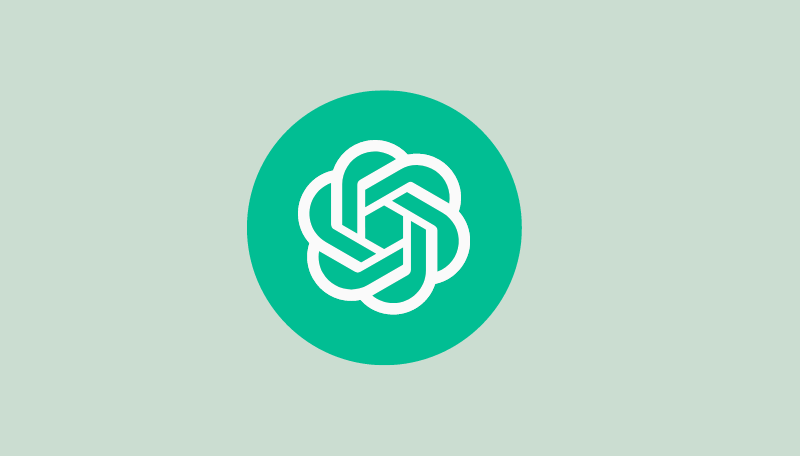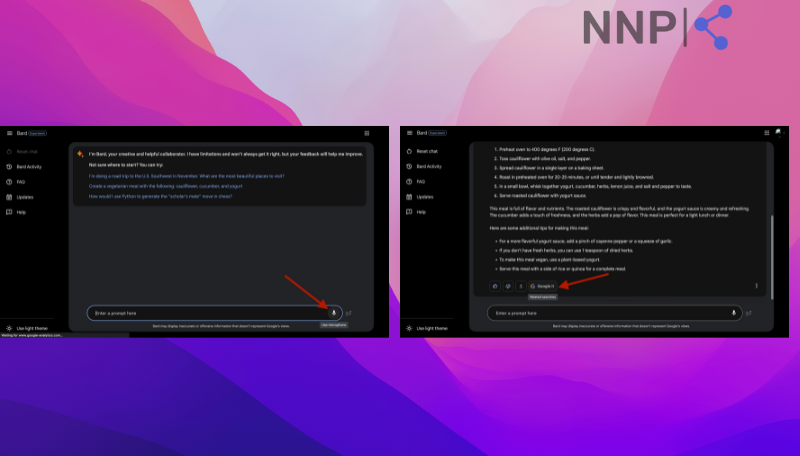Bard Vs. ChatGPT: The Major Difference Between The AI Chat Tools
Bard and ChatGPT are two notable players in the realm of conversational AI, each with its own unique characteristics and capabilities.
While both models share a common trait of understanding human language, they approach it from very different angles. Let's dive a little deeper into what makes Bard stand out and how it compares to ChatGPT.
What is ChatGPT

Before we start comparing these two chatbots, we have to know what each one of them does. Let’s start with the king of AI, ChatGPT! This chatbot is an advanced natural language processing tool developed by OpenAI, an enormous AI and research company.
It generates human-like conversations and offers various capabilities, such as answering your questions, assisting with academic tasks, and even coding.
OpenAI unveiled ChatGPT to the public on November 30, 2022, marking a significant milestone in the field of AI technology, the biggest one yet to be exact.
Its release gained attention over one night, including praise from industry experts such as Elon Musk, who described its capabilities as remarkably impressive.
Within just five days of its launch, ChatGPT amassed over a million users, indicating its rapid rise to the top
To access ChatGPT, you can visit the official website at chat.openai.com and create an OpenAI account. Yep, it’s that easy.
Also, an iPhone app is available, allowing users to engage with the chatbot conveniently from their mobile devices.
The prior version of ChatGPT is freely available for public use. Users can pose questions to their chatbot and request assistance with writing essays, coding, and more, all without any financial cost.
However, OpenAI introduced a subscription-based plan called ChatGPT Plus for those seeking additional benefits and faster answering.
By subscribing for $20 per month, users can access perks such as priority access during peak times, faster response times, and utilizing the latest model, GPT-4.
If ChatGPT reaches its capacity and displays a notification indicating service unavailability, as it does quite often, don't be alarmed!
It implies that the server is currently overwhelmed by the high volume of users. To overcome this, one can either wait and attempt to access the service at a later time when the server load has reduced or consider subscribing to ChatGPT Plus for uninterrupted access.
The versatility of ChatGPT extends beyond simple question-answering. Users employ this tool for various purposes, such as generating essay content, describing artwork with intricate details, ideating AI art prompts, engaging in philosophical discussions, making jokes, telling riddles, and even obtaining coding assistance.
ChatGPT operates on an architecture known as the Generative Pre-trained Transformer (GPT), developed by OpenAI.
While the specific variant used in ChatGPT is based on the GPT-3.5 series, ChatGPT Plus subscribers gain access to the more advanced GPT-4 model.
The underlying training process of ChatGPT involves a language model trained(NLP) on vast amounts of internet data, including websites, books, and news articles.
OpenAI further refines the model through supervised learning and reinforcement learning techniques.
The latter approach, known as Reinforcement Learning from Human Feedback (RLHF), involves human AI trainers engaging in dialogues, assuming both user and AI assistant roles, to enhance the model's performance.
What is Bard?
.png)
Bard, also a large language model (LLM), is a neural network that has undergone extensive training on a huge amount of text. Its purpose is to understand and generate human-like responses.
Developed by Google, Bard is powered by LaMDAx, the Language Model for Dialogue Applications, which was primarily introduced in 2021.
One notable aspect of Bard's training is its integration with Google Search, allowing it to stay updated with current events and expand its knowledge beyond basic language training.
Basically, Bard is the new Google help assistant, allowing you to search the wide web using your own personal chatbot as a guide.
Bard's Journey and Heritage:
While ChatGPT may have taken over the world by storm, many people don’t know that Bard has been in development for several years. In 2017, Google made its "Transformer" deep learning model available to the public, leading the way for models like ChatGPT.
Learn More: Google Presented an OpenAI Alternative-Meet Bard!
Training Data and Capabilities:
Bard and ChatGPT were trained on vast datasets of text and code. Bard has an added advantage as it incorporates Google Search results into its training.
This broadens Bard's answers and addresses a wider range of questions. With its extensive dataset and training, Bard predicts user responses and maintains a smooth conversation flow akin to human interaction.
Limitations and Fact-Checking:
While Bard demonstrates impressive conversational abilities, it's crucial to remember that it's an AI model with limitations. Like any other chatbot, Bard may not always provide accurate information.
Therefore, it's essential to fact-check and verify the information received from Bard to ensure reliability and gain a better understanding of the discussed topics. Undoubtedly, it's always smart to approach AI-generated responses at a slow pace.
ChatGPT vs. Bard, which one takes the crown?
Now, let's dive into the world of these two AI chatbots and compare them closely together.
They both offer natural language responses using machine learning and loads of data points to dish out some useful, informative answers. Well, most of the time, at least.
I gotta admit they're not perfect yet, but they sure do point towards an exciting future of AI assistants and learning tools that make information more accessible than ever and make our lives so much easier!
So, are Google Bard and ChatGPT available for action? ChatGPT has been around longer and is still the go-to choice for those eager to experiment with AI-generated text and its funny responses.
That accessibility right from the start has made ChatGPT an absolute hit. Even though the free version generates a lot of traffic that can clutter the chatbot, causing it to malfunction and stop working for a while, it is pretty helpful and can come in handy. Plus, it's free to try, folks!
On the other hand, Google Bard is slowly rolling out to users. There's a waitlist, but there are some tricks to jump to the front of that line. If you're a Google One member or part of the Pixel Superfan group, you'll get automatic access.
As for the rest of us mortals, we might have to wait a bit longer until Google opens up more spots. But patience is key, my friends!
Key differences!
Now, let's talk about differences. ChatGPT and Google Bard are like two peas in a pod, but they do have their quirks.
ChatGPT has been great at answering direct questions, but it's also causing a stir among workers like writers, SEO advisors, and copy editors.
Why, you ask? Well, it turns out ChatGPT is the Shakespeare of creative writing, but here's the catch: its accuracy and plagiarism game could be stronger.
This chatbot's talent comes from "borrowing" existing data, which might shock some of y’all, but guess what? That data is all crafted by us, who are as human as we can be. Who would've thought right?
Microsoft has even integrated ChatGPT into its Bing search engine, letting users directly ask questions instead of rummaging through keywords that take forever to go through.
They've even built it into Teams, Edge, and practically every Microsoft Office app you can imagine. Even the Opera browser plans to join the ChatGPT party soon!
The big difference between these two chatbots lies in their engines. ChatGPT rocks the GPT-3.5 model based on older data.
Google Bard, however, is powered by the LaMDA language model. But hey, having newer data doesn't automatically mean more accuracy, just so we’re clear.
Bard has had its share of problems that need resolving, like providing incorrect answers during its initial unveiling. Another reason why AIs are not to be trusted completely!
Speaking of features, both tools are pretty basic, with a simple search box as their main characteristic.
Google Bard lets you use voice prompts with your device's microphone for a hands-free and quicker experience. It even has a nifty "Google it" button that gives you links for further research outside of Bard.

And check this out. Bard offers different drafts of responses for your prompts. It's like having a chat with your own creative assistant! Plus, you can manage your privacy options and turn off activity tracking. Phew!
.png)
So, which one takes the crown, in your opinion? I think ChatGPT wins.
Comparison Table!
Tool | ChatGPT | Bard |
Language Model | Transformer 3 (GPT-3) or Generative Pre-training Transformer 4 (GPT-4), depending on the version you’re using | Google's Language Model for Dialogue Applications (LaMDA) |
Features |
|
|
Data Sources | ChatGPT underwent extensive training on an immense dataset consisting of sources such as Common Crawl, Wikipedia, books, articles, documents, and content from the open internet. However, it's important to note that the training data for ChatGPT only goes up until 2021, which means its knowledge of recent world events and the latest research is limited. While ChatGPT excels at understanding and generating human-like text based on the information it has been trained on, it may not possess the most up-to-date knowledge in certain domains. | Bard was trained on a comprehensive dataset called Infiniset, which includes a wide range of sources such as Common Crawl, Wikipedia, documents, and online conversations and dialogues. What sets Bard apart is its ability to tap into the web in real-time, unlike ChatGPT, allowing it to search for the most up-to-date answers to questions and access the latest research available. By incorporating Google Search into its training process, Bard gains a distinct advantage in staying current with the ever-changing information landscape. |
Pricing plans | Free version(ChatGPT-3.5), and ChatGPT-4 pricing $20/month. Available almost everywhere in the world. | Google Bard AI is now available to everyone, and you can use it for free. Google has expanded Bard chatbot access to over 180 countries |
Final Thoughts!
In conclusion, both Bard and ChatGPT represent significant advancements in the field of conversational AI, offering unique characteristics and capabilities.
While they share the common goal of understanding human language, each approaches it from a different perspective.
ChatGPT, developed by OpenAI, has quickly gained popularity since its release in 2022. It has garnered praise for its impressive conversational abilities and has amassed a large user base.
With its freely accessible version and subscription-based ChatGPT Plus, it caters to a wide range of users, from those seeking casual interactions to those requiring faster and more advanced responses.
Bard, on the other hand, is a product of Google's extensive research and development efforts. Powered by the LaMDA language model and integrated with Google Search, it offers a comprehensive approach to generating human-like responses.
Bard's training with up-to-date information from the web enables it to provide more thorough answers and address a broader range of user queries.
Both ChatGPT and Bard have their strengths and limitations. ChatGPT's ability to engage in creative writing and its integration with various platforms make it a convenient choice for many users. However, concerns have been raised regarding accuracy and plagiarism.
With its newer LaMDA engine and draft response options, Bard offers a hands-free experience and additional privacy controls. However, it also faced initial challenges in providing accurate answers.
As the AI chatbot landscape continues to evolve, it's essential to approach AI-generated responses with a critical mindset.
While these tools provide valuable assistance and information, fact-checking and verification remain crucial to ensure accuracy and reliability.
In summary, both ChatGPT and Bard contribute to the advancement of conversational AI, making information more accessible and interactions more engaging.
They cater to different user preferences and needs, and as they further develop and improve, we can expect even more impressive capabilities from these AI chat tools.
